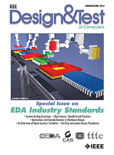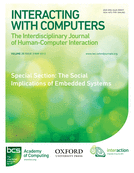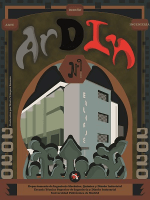
RESEARCH IN ENGINEERING DESIGN
Scope & Guideline
Fostering collaboration for groundbreaking engineering design.
Introduction
Aims and Scopes
- Generative Design Methodologies:
The journal emphasizes methodologies that facilitate generative design, exploring both quantitative and qualitative objectives to enhance design outcomes. - Automation in Design Processes:
A consistent focus on automating design processes, including the development of systematic approaches for generating design options from existing product families. - Design for Sustainability:
Research that integrates sustainability into design practices, such as circular economy principles and design for durability. - Cross-Disciplinary Approaches:
Encourages interdisciplinary research that combines insights from various fields to tackle complex design problems and improve product development. - User-Centered Design:
Focuses on methodologies that incorporate user preferences and experiences into the design process, ensuring that the end products meet user needs. - Complexity Management in Engineering Design:
Addresses the challenges of managing complexity in engineering design, including the analysis of engineering change and assembly complexity. - Innovative Evaluation Methods:
Develops new metrics and frameworks for evaluating design effectiveness, particularly in early stages and across various engineering domains.
Trending and Emerging
- Artificial Intelligence in Design:
A significant trend is the exploration of AI applications in engineering design, particularly in automating processes and improving design decision-making. - Industry 4.0 and Smart Manufacturing:
Publications are increasingly addressing the integration of Industry 4.0 technologies in design processes, reflecting the industry's shift towards smart manufacturing and digital transformation. - Sustainability and Circular Design:
There is a growing emphasis on sustainable design practices, including circularity and durability, as industries prioritize environmental impact and resource efficiency. - User Experience and Human-Centered Design:
Research focusing on user experience and engagement in the design process is emerging, highlighting the importance of aligning design outcomes with user needs and preferences. - Complex System Design and Management:
An increasing interest in managing complexity in design processes is evident, with studies focusing on frameworks and methodologies to handle multifaceted design challenges. - Design Education and Methodology:
Emerging discussions around design education methodologies indicate a trend towards improving how engineering design is taught, with a focus on practical applications and interdisciplinary learning.
Declining or Waning
- Traditional Design Methodologies:
There is a noticeable decline in the publication of papers focused on traditional, linear design methodologies, as the field shifts towards more dynamic and iterative approaches. - Basic Prototyping Techniques:
As the emphasis on advanced technologies and methodologies increases, basic prototyping techniques are being addressed less frequently in recent publications. - Single-Disciplinary Research:
Research that does not incorporate cross-disciplinary perspectives is becoming less common, reflecting a trend toward holistic approaches that draw on multiple fields. - Static Design Evaluation Metrics:
The use of static metrics for evaluating design processes is declining as researchers seek more adaptive and context-aware evaluation frameworks.
Similar Journals

IEEE Design & Test
Innovating Design and Testing for Tomorrow's TechnologiesIEEE Design & Test is a leading academic journal published by the IEEE-INST ELECTRICAL ELECTRONICS ENGINEERS INC, dedicated to advancing the fields of Electrical and Electronic Engineering, Hardware and Architecture, and Software. With an ISSN of 2168-2356 and an E-ISSN of 2168-2364, the journal spans from 2013 to 2024, offering valuable insights and peer-reviewed research that addresses critical challenges in the design, verification, and testing of electronic systems. Recognized for its quality, the journal holds a Q2 designation in Electrical and Electronic Engineering and ranks within the top quartiles of its category, making it a notable resource for professionals and scholars alike. Its Scopus rankings, particularly a rank of #354 in Electrical and Electronic Engineering, underscores its significance and relevance in the rapidly evolving technological landscape. Although not currently open access, the journal remains committed to disseminating innovative research that shapes the future of technology, ensuring that researchers and practitioners stay at the forefront of their disciplines. IEEE Design & Test serves as an essential platform for exchanging ideas, fostering collaboration, and driving advancements in engineering and computer science.

INTERACTING WITH COMPUTERS
Unveiling the Dynamics of Digital EngagementINTERACTING WITH COMPUTERS is a renowned journal published by Oxford University Press, focusing on the interdisciplinary field of Human-Computer Interaction, as well as aspects of Library and Information Sciences and Software. With a rich history of publication since 1989, this journal has established itself as a significant platform for scholars to disseminate cutting-edge research and innovative methodologies that enhance our understanding of how humans engage with technology. Despite being classified in the Q3 and Q2 quartiles across various categories, its 2023 Scopus rankings highlight its relevance, positioning it within the 69th percentile for Library and Information Sciences. This makes it an essential resource for researchers, professionals, and students looking to stay informed about the latest advancements and discussions in this rapidly evolving domain. Though not currently open access, INTERACTING WITH COMPUTERS offers substantial insights that are crucial for driving forward the conversation in Human-Computer Interaction, ensuring its relevance in both academic and applied contexts.

ArDIn-Arte Diseno e Ingenieria
Advancing the Intersection of Art and EngineeringArDIn-Arte Diseno e Ingenieria is a prominent open-access journal published by UNIV POLITECNICA MADRID, dedicated to advancing the fields of design and engineering. Since its inception in 2012, this journal has rapidly become an essential resource for researchers, professionals, and students alike, focusing on the integration of innovative practices and methodologies within the realms of art, design, and engineering. With an E-ISSN of 2254-8319, ArDIn fosters a platform for scholarly discussions, disseminating significant original research, reviews, and case studies that push the boundaries of interdisciplinary collaboration. Based in Madrid, Spain, the journal emphasizes the importance of accessibility in academic publishing, ensuring that a diverse audience can benefit from its high-quality content. As ArDIn continues to grow in reputation and impact, it remains committed to enhancing the knowledge landscape within the ever-evolving field of design and engineering.

AI EDAM-ARTIFICIAL INTELLIGENCE FOR ENGINEERING DESIGN ANALYSIS AND MANUFACTURING
Revolutionizing Manufacturing Practices with Cutting-Edge AI ResearchWelcome to AI EDAM - ARTIFICIAL INTELLIGENCE FOR ENGINEERING DESIGN ANALYSIS AND MANUFACTURING, a leading journal published by Cambridge University Press. This esteemed journal focuses on innovative research at the intersection of artificial intelligence and engineering design, analysis, and manufacturing, making it an essential resource for academics, industry professionals, and students alike. With an ISSN of 0890-0604 and an E-ISSN of 1469-1760, AI EDAM has established itself within the academic community, reflected in its impressive Scopus rankings: a Q3 journal in Artificial Intelligence and a Q2 journal in Industrial and Manufacturing Engineering. Covering years from 1987 to 2024, this journal emphasizes the rapidly evolving nature of engineering practices influenced by AI technologies. With robust contributions to the fields of engineering and computer science, AI EDAM serves as a crucial platform for disseminating scholarly work that fosters advancements in design and manufacturing methodologies.

JMIR Formative Research
Catalyzing Progress in Formative Research for Global ImpactJMIR Formative Research, published by JMIR PUBLICATIONS, INC, is a leading open-access journal that has been at the forefront of innovation in the fields of Health Informatics and Medicine since its establishment in 2017. With its commitment to disseminating high-quality research, JMIR Formative Research aims to foster interdisciplinary collaboration and catalyze advancements in formative research methodologies across various medical domains. The journal is currently indexed in Scopus, holding a respectable Q3 position in Health Informatics and Q2 in Medicine (miscellaneous), reflecting its growing influence and relevance in these dynamic fields. Researchers, professionals, and students alike will find valuable insights and contributions that not only enhance their understanding of contemporary health issues but also guide the development of future health technologies and practices. With open access available since inception, JMIR Formative Research ensures that critical findings are accessible to a global audience, encouraging knowledge sharing and the potential for real-world impact.

Journal of the International Association for Shell and Spatial Structures
Innovating the Landscape of Structural EngineeringJournal of the International Association for Shell and Spatial Structures (ISSN: 1028-365X, E-ISSN: 1996-9015) is a leading scholarly publication published by the International Association for Shell and Spatial Structures (IASS), based in Spain. The journal spans a remarkable history from 1969 to 2024, fostering groundbreaking research in the fields of shell and spatial structures while also contributing to broader disciplines such as arts and humanities, civil and structural engineering, and mechanical engineering. Notably, the journal has been recognized with a Q2 ranking in Arts and Humanities (Miscellaneous) and Q3 rankings in Building and Construction, Civil and Structural Engineering, and Mechanical Engineering for 2023. This positioning indicates a strong impact within its categories, enhancing the visibility of innovative research and practices. Although not labeled as open access, the journal remains a crucial resource for researchers, professionals, and students captivated by the complexities of structural design and engineering. By promoting interdisciplinary approaches and emerging technologies in structural systems, the journal serves as an indispensable platform for academic discourse and practical advancements in the field.

Interaction Design and Architectures
Connecting Ideas, Shaping SpacesInteraction Design and Architectures is a prominent open-access journal specializing in the intricate fields of interaction design, architecture, and beyond, published by INTERACTION DESIGN & ARCHITECTURES based in Italy. Since its inception in 2005, this journal has provided a vital platform for researchers, professionals, and students to disseminate their findings and insights in a rapidly evolving landscape. With an impressive H-index, it maintains rigorous academic standards and is recognized across several categories, achieving Q2 rankings in Architecture, Media Technology, and Social Sciences as of 2023, demonstrating its multidisciplinary appeal and significance in integrating diverse fields. The journal's committed editorial board and peer-review process ensure that high-quality research reaches its audience, promoting innovative discourse in interaction design and architecture. Access to this journal is facilitated through an open-access model, making the latest advances accessible to all interested parties. As the field continues to grow and adapt, Interaction Design and Architectures remains a cornerstone for impactful research and intellectual exchange.

CHEMICAL ENGINEERING & TECHNOLOGY
Connecting Theory and Practice in Chemical EngineeringChemical Engineering & Technology is a prestigious journal published by Wiley-VCH Verlag GmbH, focusing on the evolving field of chemical engineering and its related disciplines. With an ISSN of 0930-7516 and E-ISSN of 1521-4125, the journal has established a robust platform for researchers and practitioners to share pioneering studies and innovative technologies within the field. Classified in the second quartile (Q2) across multiple categories such as Chemical Engineering, Chemistry, and Industrial and Manufacturing Engineering, it holds an impressive rank in the Scopus database, indicating its significant contribution to the academic community. The journal's commitment to advancing knowledge is reflected in its extensive convergence of research from 1987 to 2024, providing a comprehensive archive of scholarly work. Researchers, professionals, and students benefit from the latest insights and findings, enriching the dialogue around chemical processes and methodologies. Though it operates under a traditional subscription model, the accessibility of this journal is crucial for those engaged in both theoretical and applied aspects of chemical engineering.

i2 Investigacion e Innovacion en Arquitectura y Territorio
Bridging academia and practice for a sustainable future.i2 Investigacion e Innovacion en Arquitectura y Territorio is a leading open-access journal published by the University of Alicante, dedicated to advancing research and innovation in the fields of architecture and territorial development. Since its inception in 2013, this journal has aimed to provide a robust platform for scholarly discourse, promoting interdisciplinary approaches that connect academic insights with practical applications in urban planning and environmental design. With its commitment to accessibility, the journal ensures that cutting-edge findings and case studies are readily available to researchers, professionals, and students alike, fostering collaboration and informed decision-making. As the landscape of architecture and geography continues to evolve, the i2 journal stands out as a crucial resource for enhancing knowledge and cultivating innovative practices in these dynamic fields.

COMPUTER AIDED GEOMETRIC DESIGN
Bridging Disciplines with Geometric PrecisionCOMPUTER AIDED GEOMETRIC DESIGN is a premier journal dedicated to the interdisciplinary field of geometric design, showcasing cutting-edge research that intersects with Aerospace Engineering, Automotive Engineering, and Computer Graphics. Published by ELSEVIER in the Netherlands, this esteemed journal has maintained its relevance and impact since its inception in 1984, with a converged publication strategy continuing through 2024. Currently categorized in Q2 across multiple domains, including Aerospace Engineering and Computer-Aided Design, it reflects a solid standing within the academic community. Researchers can access high-quality articles, contributing to the advancement of applied mathematics and simulation methodologies. Despite not being an open-access journal, it offers significant insights that support innovation in design processes, making it a vital resource for academics, professionals, and students aiming to deepen their understanding and explore new possibilities in geometric design and related fields.